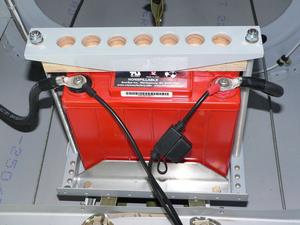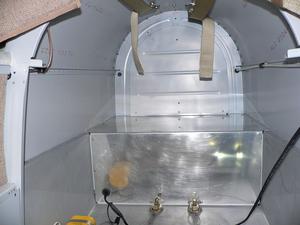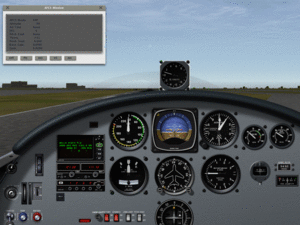Progress Again
- Details
- Written by Kevin Horton
- Hits: 4050
Dealing with the fallout from the heat pump failure killed any chance to work on the aircraft during the week, but I got a fair bit of work done last Sunday, yesterday and today. I hope to get another burst of work done on Monday.
Lesson 1 - Install the rear seat air duct onto the NACA scoop before mounting the wings. It would have been a piece of cake to pull the other end of the duct into the fuselage after mounting the wings. Instead, I spent an hour with one arm jammed through an inspection cover on the bottom of the wing, trying to get the duct over the NACA scoop outlet, then getting the worm clamp installed. It is amazing what you can do with only one hand if you have no other choice. Not fun.
Lesson 2 - Don't put UHMW tape on the bottom of the upper wing skin ahead of the flap. I had done that instead of putting the tape on the flap, as I thought it would look better. But, when I installed the flap I found that the aft edge of that tape was loose in a couple of spots. No big deal, I thought, I'll just remove the tape and put a new piece on. Well, when you pull the tape off, it leaves a whole bunch of adhesive behind, and it is a real pain in the butt to clean it off the bottom of the upper wing skin as the flaps get in the way. I didn't want to remove the flaps as it was a pain in the butt to get the hinge pins in place, and I didn't want to have to do that any more often than necessary. I would have been a lot easier to be removing adhesive from the upper surface of the flap skin, as at least you have good access to that area without removing the flaps. So, once I finally got the adhesive off, I put the replacement UHMW tape on the flap, instead of the wing skin.
 I did the final installation of the battery - I used an Odyssey PC680 battery, which was quite a bit smaller than the one that the battery tray was designed for. I made the tray narrower by bolting in two pieces of aluminum angle. Van's design uses a piece of U-shaped channel on top of the battery to hold it into the tray. The channel is supposed to be placed with the flat face against the top of the battery. But, with the narrower PC680, the two terminals would then be very, very close to the channel, creating a large risk of the positive terminal shorting against the channel. I flipped the channel upside down, trimmed the edges at an angle, and put a piece of oak between the channel and the battery. This moved the metal channel well away from the battery terminals, but it had the knock-on effect of making the supplied hold-down bolts too short, so I used red (permanent) Loctite to bond nuts to one end of threaded rod to effectively make longer bolts (I couldn't find sufficiently long 1/4" bolts at any local source.)
I did the final installation of the battery - I used an Odyssey PC680 battery, which was quite a bit smaller than the one that the battery tray was designed for. I made the tray narrower by bolting in two pieces of aluminum angle. Van's design uses a piece of U-shaped channel on top of the battery to hold it into the tray. The channel is supposed to be placed with the flat face against the top of the battery. But, with the narrower PC680, the two terminals would then be very, very close to the channel, creating a large risk of the positive terminal shorting against the channel. I flipped the channel upside down, trimmed the edges at an angle, and put a piece of oak between the channel and the battery. This moved the metal channel well away from the battery terminals, but it had the knock-on effect of making the supplied hold-down bolts too short, so I used red (permanent) Loctite to bond nuts to one end of threaded rod to effectively make longer bolts (I couldn't find sufficiently long 1/4" bolts at any local source.)
The two smaller wires on the battery terminals are for a battery charger. The other end of the battery charger wire will come out in the baggage area, and has a connection with a cover to keep it clean. This will allow me to charge the battery with a trickle charger without having to remove the rear baggage shelf.
 After mounting the battery, I installed the aft baggage shelf (which covers the battery), and the cover at the back of the baggage bay. If past experience holds, within the next two weeks I'll discover some reason why I need to remove those items to access that area. But, the project is slowly approaching its end, and I need to close in each area eventually, so I rolled the dice and put those items in place.
After mounting the battery, I installed the aft baggage shelf (which covers the battery), and the cover at the back of the baggage bay. If past experience holds, within the next two weeks I'll discover some reason why I need to remove those items to access that area. But, the project is slowly approaching its end, and I need to close in each area eventually, so I rolled the dice and put those items in place.
You can see the other end of the battery charger wire over to the left side of the picture.
You can also see two of the four removable tie down points that will be used to secure baggage in place (and will also be used to secure ballast during the flight test phase.)
Today I spent quite a bit of time fiddling away inside the left landing gear box, securing the pitot line in place to ensure it doesn't chafe against anything. Then I hit a phase where everything I tried to work on required something that wasn't at the hangar, so I eventually got frustrated and came home to spend some time with Terry.
Heat Pump Tribulations
- Details
- Written by Kevin Horton
- Hits: 2954
I hadn't gotten any work done for almost three weeks, due to travel and a major winter storm. I booked Thursday afternoon and Friday off, and was really looking forward to getting back at the project. I got home from work after lunch on Thursday, planning to quickly change and head for the hangar. But, I noted that the house was quite cold, and found that the water source heat pump was not working. I called our local heating and cooling contractor, and waited for him to show up. He came by mid-afternoon, did some disassembly and troubleshooting, and determined that the compressor had failed. Worse, the heat pump manufacturer had gone out of business many years ago, and parts were hard to find. And, the heat pump had already exceeded its expected lifetime, and many other components looked to be in bad shape. He recommended that I replace it with a new heat pump, rather than spending a bunch of money on one that was on its last legs.
That killed Thursday afternoon. I had to go to Home Depot to purchase three electric heaters to knock the chill off the house, and I had to contact an official auditor to discuss how to tap into a government grant program to fund energy efficient upgrades. My heating contractor said they would cover part of the cost of a new heat pump, even if the old one was dead, as long as the new one met some magic energy efficiency standard. I made an appointment with the auditor for Friday afternoon. Monday I'll contact another heating contractor to get another quote on a new heat pump, as the price the first guy quoted me was a whole bunch more than I expected. I need to figure out whether he was fishing to make some money, or whether these things are really that expensive. If it costs as much as he quoted me, I'll have to cash in a bunch of my banked comp time rather than using it to work on the aircraft.
I had known that this brand heat pump didn't have a great service history, that the manufacturer was long gone, and that ours was getting pretty tired. So, I'm not terribly surprised that it has died. But I am not happy to be spending a bunch of money and time on it, when I really just want to get this aircraft in the air. The only consolation is that apparently the current generation heat pumps are much better quality than the one that died.
Friday morning I did manage to get out to the hangar to get some work done. Nothing major to report, but I did close off a few very small items. It seems like I spent most of the time making a list of the stuff that I should have brought with me, but had left in the basement.
No Progress - Savannah, Snow
- Details
- Written by Kevin Horton
- Hits: 3591
I have made zero progress in the last two weeks due to a combination of travel and weather.
Sunday, February 24th I flew to beautiful Savannah, GA for two weeks, and got back a bit after midnight on Friday night, March 7th (or perhaps more accurately, early Saturday morning). The trip to Savannah was to conduct type certification flight tests so Transport Canada will eventually be able to issue Type Certificates for the Gulfstream G350, G450, GV, G500 and G550. I didn't fly all five models, as they are more similar than different. But I did do two flights on the prototype GV, and one flight on the prototype G450. The time not flying was spent in meetings, reviewing various aspects of the design and Gulfsteam's flight test program.
Savannah is an absolutely wonderful small city, with a huge number of beautiful old houses in the downtown core. I didn't mind the nice weather either, as I needed a break from winter. We had one day off in the two weeks, so on Sunday morning I visited the Mighty Eighth Air Force Museum, which covers the history of the US Army Air Force 8th Air Force, which was formed in Savannah in 1942, and then moved to England for the rest of WWII, eventually growing to over 200,000 personel, and suffering over half of the casualties of the whole US Army Air Force. In the afternoon I visited RV-10 builder Todd Swezey, and then drove down to the Eagle Neck Airpark where I met several RV builders and flyers.
 I had hoped to work on the aircraft today, but the 51 cm of snow that we got in the storm that ended this morning killed that idea. There is no chance that I would have been able to drive to the hangar. I'll give them a few days to clear the taxiways before I chance it.
I had hoped to work on the aircraft today, but the 51 cm of snow that we got in the storm that ended this morning killed that idea. There is no chance that I would have been able to drive to the hangar. I'll give them a few days to clear the taxiways before I chance it.
I worked long hours in Savannah, and built up quite a bit of comp time. I hope to take several days off over the next few weeks so I can make progress on the RV-8.
Pitot Tube Installation
- Details
- Written by Kevin Horton
- Hits: 3407
I got out to the hangar for several hours on Monday and Thursday. I got a few small things finished off, but the big progress was on the pitot tube. I soldered the pins for the pitot heat connector to the pitot heat wires, installed the pitot tube, did a functional test of the pitot heat, and connected the pitot line to the pitot tube. Then I installed the access covers on the bottom of the left wing.
Everything on the left wing is now complete from the wing tip to about 6 inches from the wing root (I need to install the fuel and fuel vent lines, and hook up the fuel quantity sender to the fuel gauge). Everything on the right wing is complete from the wing tip to the NACA scoop under the wing (I need to hook up the OAT probe, fresh air vent tube, fuel quantity sender wires, fuel line and fuel vent line). Everything on the fuselage is complete from the tail to the aft baggage compartment (except for two screws in the rudder bottom, and the tail wheel springs).
Elevator Pushrod Binding Fixed
- Details
- Written by Kevin Horton
- Hits: 3334
I was on the road for most of the week, so didn't get out to the hangar to work on the aircraft until today.
This morning I attacked the problem of the aft end of the forward elevator pushrod rubbing inside the torque tube that connects the two control sticks. I disconnected both pushrods at the aft control stick, and peered inside the torque tube with a mirror. It was clear that there was nothing sticking down from the top of the torque tube, nor was there any anomaly with the pushrod. The problem is that the bottom of the stick rises as the stick is pulled aft, and this brings the pushrod closer and closer to the inside of torque tube. I had rigged the aft stick angled a bit aft to ensure that it didn't hit the front seat back at full forward stick. This probably is why the aft end of the forward pushrod hits the torque tube at full aft stick.
Today I lengthened the forward pushrod, and shortened the next most aft pushrod, to change the angle of the rear stick. Now there is no interference problem at full aft stick. I forgot to take the front seat back to the hangar, so I couldn't check to see whether I will have to put a bend in the rear stick. But, even if I need a bend in that stick, this isn't a problem for now, as the aft stick won't be installed until I start carrying passengers, which will be many hours after first flight.
I rechecked the elevator travel, and found it matched Van's recommended limits, except the down elevator travel was about a half degree more than recommended. This shouldn't cause any issues in service, so I am not going to do anything about it.
I adjusted the lengths of the two long aileron pushrods to put the stick vertical when the ailerons were neutral, then measured the aileron travel. Everything was inside the recommended limits.
The freezing rain that was forecast arrived earlier than expected, so I shut down operations and came home before the roads got too treacherous.
Autopilot Update
- Details
- Written by Kevin Horton
- Hits: 6706
 While I was in Salt Lake City two weeks ago I re-attacked the problem of using X-Plane as a simulator to help design control laws for a pitch axis autopilot, which would use electric trim commands to control the aircraft in pitch. I was stuck for awhile, but eventually got all the hooks to X-Plane working so I could read the data from the sim, display an autopilot control panel, and control the sim with the simulated autopilot. Today I did some more work, and now I've got a pitch hold mode working quite well, and am working on an altitude hold mode.
While I was in Salt Lake City two weeks ago I re-attacked the problem of using X-Plane as a simulator to help design control laws for a pitch axis autopilot, which would use electric trim commands to control the aircraft in pitch. I was stuck for awhile, but eventually got all the hooks to X-Plane working so I could read the data from the sim, display an autopilot control panel, and control the sim with the simulated autopilot. Today I did some more work, and now I've got a pitch hold mode working quite well, and am working on an altitude hold mode.
I am experimenting with some things, such as adaptive autopilot gains. The gain required will vary considerably depending on the CG, and the airspeed. The autopilot starts off with a low gain, and if the performance is not good enough it automatically slowly increases the gain until the performance is acceptable. If the gain gets too high, and its commands cause the aircraft pitch to start to oscillate, it quickly backs off on the gain until the oscillation stops. This part works quite well, at least in the simulator. It'll be interesting to see how well it works in the aircraft. This feature, if it works, should make it possible to use this autopilot on many other aircraft types without changing the software.
Originally, I was considering using the Arduino micro-controller as the basis for the autopilot. Now I am considering the Parallax Propeller micro-controller. The Propeller is interesting because it has what are effectively eight separate CPUs (they call them cogs), sharing common memory. You can dedicate CPUs to specific functions, and they can whir away without being affected by what is happening in the other cogs. For example, I would dedicate one cog to reading the serial data from the Dynon EFIS, another cog would monitor the pilot selections from the control panel and display status info on an LCD display. Another cog would do the inner loop control law, which would be a pitch hold law. Another cog would do the outer loop control laws (e.g. altitude hold, airspeed hold, vertical speed hold, etc) which would send pitch attitude commands to the inner loop control law. Another cog would act as a safety monitor, and would disconnect the autopilot if one of the other cogs locked up, or if specified airspeed or load factor limits were exceeded.
This should be a fun project. If it works, I'll share the design info with the amateur-built aircraft community.
